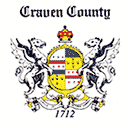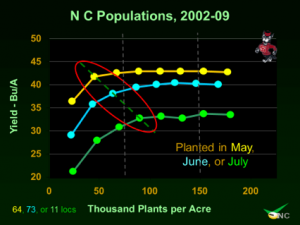Early Season Management Choices to Optimize Potential Soybean Profit
go.ncsu.edu/readext?409401
en Español / em Português
El inglés es el idioma de control de esta página. En la medida en que haya algún conflicto entre la traducción al inglés y la traducción, el inglés prevalece.
Al hacer clic en el enlace de traducción se activa un servicio de traducción gratuito para convertir la página al español. Al igual que con cualquier traducción por Internet, la conversión no es sensible al contexto y puede que no traduzca el texto en su significado original. NC State Extension no garantiza la exactitud del texto traducido. Por favor, tenga en cuenta que algunas aplicaciones y/o servicios pueden no funcionar como se espera cuando se traducen.
Português
Inglês é o idioma de controle desta página. Na medida que haja algum conflito entre o texto original em Inglês e a tradução, o Inglês prevalece.
Ao clicar no link de tradução, um serviço gratuito de tradução será ativado para converter a página para o Português. Como em qualquer tradução pela internet, a conversão não é sensivel ao contexto e pode não ocorrer a tradução para o significado orginal. O serviço de Extensão da Carolina do Norte (NC State Extension) não garante a exatidão do texto traduzido. Por favor, observe que algumas funções ou serviços podem não funcionar como esperado após a tradução.
English
English is the controlling language of this page. To the extent there is any conflict between the English text and the translation, English controls.
Clicking on the translation link activates a free translation service to convert the page to Spanish. As with any Internet translation, the conversion is not context-sensitive and may not translate the text to its original meaning. NC State Extension does not guarantee the accuracy of the translated text. Please note that some applications and/or services may not function as expected when translated.
Collapse ▲Authors: Mike Carroll, Extension Agent, Craven County and Mark Seitz, County Extension Director, Pender County
Soybean prices are significantly lower than years past with little indication of any significant increase in value in the coming years. Production inputs have decreased slightly yet profit margins remain small to non-existent. To increase the potential profit, often one needs to examine actual production inputs closely. Some inputs may need to be eliminated, while others incorporated into production or some simply fine-tuned.
The first choice of management should include selection of a great yielding variety. Nematode resistance, disease resistance, maturity group, harvest date and herbicide traits are all critical criteria. However, choosing a variety that yield 8% less than others with similar characteristics and traits (assuming a 40 bu/ac yield average is possible) results in production of 3.2 bu/ac less soybeans per acre. Based on current price range, this eliminates $25-30/ac of potential profit for no other reason than poor varietal choice. Review soybean yield data by historic yield within NC at http://soyvar.ncsu.edu/ or review select varieties by varying potential yield environments at https://soybeans.ces.ncsu.edu/2016-north-carolina-soybean-variety-information/. Choose wisely.
The next step should be to consider weed control. Within much of Eastern NC, both glyphosate resistant horseweed (or mare’s tail) as well as glyphosate & ALS resistant Palmer amaranth (pigweed) are common. Thus, tillage for conventional production or a burndown herbicide that includes either 2,4-D or Clarity tank mixed with glyphosate for reduced or no-till production applied prior to planting is advised. Adding a pre-emergence herbicide material will increase weed control as well as ensure that planting occurs into a weed-free seedbed. Simply read the product labels to ensure products are applied according to any planting restrictions. As an alternative, consider glyphosate + 2,4-D or Clarity prior to planting and Gramoxone plus a residual herbicide at planting.
Seeding rate should be examined closely. Research from Dr. Jim Dunphy, NCSU Crop Science Professor and Extension Soybean Specialist, shows 75,000 plants per acre is the ideal population to maximize yield with the lowest planted population. Yes, this sounds low and it is probably well below the comfort level for many farmers. Yet research from over 73 locations across NC between 2002-2009 show that soybean yield simply begins to level out at populations greater than 75,000 plant/acre. (see graph below). Simply put, there is no additional yield advantage to plant more seed. Additionally, this population recommendation does not vary whether planted to 7”, 15”, 20” or 30” rows.
Often producer adjust rates according to planting date. While this is feasible on certain soils and situations, note that research data shows that only a slight increase in seeding rate is justified. According to data, yields tend to level for May planted soybeans at about 60,000 plants per acre and about 80,000-90,000 plants per acre for June and July planted soybeans. Thus, the target rate of 75,000 plants per acre fits all planting dates as an average.
In addition to a target population, seed quality or percent germination must also be considered. Dividing the target final plant population by the percent germination will provide the seeding rate per acre. Normally, these two numbers are very similar. (Target plant population per acre of 75,000 plants with seeds with a 95% germination results in a seeding rate of 78,950 seeds per acre).
While lower populations will save money on seed, it will also require more timeliness for weed control. Fewer plants per acre will increase the soil surface exposed to direct sunlight for a longer period of time that potentially will increase the amount of weed seed germinating. This adds even more emphasis for the need to include a good pre-emergence herbicide at planting since glyphosate and ALS inhibitors are not likely to control horseweed or pigweed. Too, these pre-emergence materials normally control, or at least suppress weed growth, long enough so that timely post-emergence application can be made, even when the post-emergence herbicide application is postponed slightly due to adverse weather. Simply aim to apply post-emergence herbicide(s) when the weeds are small (2” to 4”) to maximize weed control and yield reduction due to weeds.
Following these guidelines provides management of factors that producers can control. Given the current and expected continuance of lower soybean prices, it is wise to provide the best management choices available and to avoid unwarranted expenses. Saving a few dollars on inputs here and there may make a difference between a profitable and non-profitable crop.
Contact the authors: mike_carroll@ncsu.edu mark_seitz@ncsu.edu





